A Novel Nickel-Plated Carbon Fiber Insert in Aluminum Joints with Thermoplastic ABS Polymer or Stainless Steel
Abstract
:1. Introduction
2. Materials and Methods
2.1. Sample Preparation
2.2. Ni Coating Process (STEP 1)
2.3. Al/Ni-CFP/ABS Joint (STEPS 2 and 3)
2.4. Al/Ni-CFP/18-8 Joint (STEPS 2 and 3)
2.5. Tensile Testing and Characterization
3. Results and Discussion
3.1. Increase in UTS by Ni-CFP Plug
 Al/Ni-CFP/ABS (16 times), and no adhesion of Al/18-8 to Al/Ni-CFP/18-8.
Al/Ni-CFP/ABS (16 times), and no adhesion of Al/18-8 to Al/Ni-CFP/18-8.3.2. Rule of Mixtures Calculation for Corrected (Normalized) cσT (cUTS) for CFRP Fractional Cross-Sectional Area
3.3. Resistance Energy to Tensile Deformation, UT
3.4. Stress-Strain Curves and Specific Tensile Strength, ssT
 Al/CFP/18-8
Al/CFP/18-8  Al/Ni-CFP/ABS
Al/Ni-CFP/ABS  Al/Glue/ABS
Al/Glue/ABS  Al/ABS.
Al/ABS.3.5. Specific Resistance Energy to Tensile Deformation
3.6. Fracture Mechanisms of Al-ABS Joints
3.7. Fracture Mechanisms of Al-18-8 Joints
3.8. Metallographic Processes of Al Half-Length: XRD and EPMA Data
3.9. Metallographic Processes of 18-8 Half-Length: XRD and EPMA Data
4. Conclusions
Author Contributions
Funding
Institutional Review Board Statement
Informed Consent Statement
Data Availability Statement
Acknowledgments
Conflicts of Interest
References
- Drozdov, A. Aluminium: The Thirteenth Element; RUSAL Library: Moscow, Russia, 2007; ISBN 978-5-91523-002-5. [Google Scholar]
- Nishi, Y.; Inoue, K.; Salvia, M. Improvement of Charpy impact of carbon fiber reinforced polymer by low energy sheet electron beam irradiation. Mater. Trans. 2006, 47, 2846–2851. [Google Scholar] [CrossRef]
- Nishi, Y.; Takei, H.; Iwata, K.; Salvia, M.; Vautrin, A. Effects of electron beam irradiation on impact value of carbon fiber reinforced thermoplastic polyetheretherketone. Mater. Trans. 2009, 50, 2826–2832. [Google Scholar] [CrossRef]
- Takei, H.; Iwata, K.; Salvia, M.; Vautrin, A.; Nishi, Y. Effects of electron beam irradiation on impact value of novolak-type phenol CFRTP. Mater. Trans. 2010, 51, 2259–2265. [Google Scholar] [CrossRef]
- Yang, Q.; Mironov, S.; Sato, Y.S.; Okamoto, K. Material flow during friction stir spot welding. Mater. Sci. Eng. A 2010, 527, 4389–4398. [Google Scholar] [CrossRef]
- Daily Metal Prices. Available online: https://www.dailymetalprice.com/metalprices.php (accessed on 23 February 2023).
- Shiraishi, K.; Inui, S.; Ishii, S.; Matsumura, Y.; Nishi, Y. Tensile Strength of Al/ABS-CFRP Joint Reinforced by Nickel Coated Carbon Fiber Cloth. Mater. Trans. 2014, 55, 1564–1567. [Google Scholar] [CrossRef]
- Tomizawa, M.; Faudree, M.C.; Kitahara, D.; Takase, S.; Matsumura, Y.; Jimbo, I.; Salvia, M.; Nishi, Y. A Novel Joint of 18-8 Stainless Steel and Aluminum by Partial Welding Process to Ni-Plated Carbon Fiber Junction. Mater. Trans. 2020, 61, 2292–2301. [Google Scholar] [CrossRef]
- Shackelford, J.F. Introduction to Materials Science for Engineers, 5th ed.; Prentice Hall International: London, UK, 2000; pp. 136, 137, 194, 412. [Google Scholar]
- Handbook of Stainless Steel; Outokumpu: Outokumpu Oyj, Finland, 2013; p. 22.
- Lu, T.; Chen, W.-T. Material recycling of Acrylonitrile Butadiene Styrene (ABS) from toy waste using density separation and safer solvents. Resour. Conserv. Recycl. 2023, 197, 107090. [Google Scholar] [CrossRef]
- Dul, S.; Gutierrez, B.J.A.; Pegoretti, A.; Alvarez-Quintana, J.; Fambri, L. 3D printing of ABS Nanocomposites. Comparison of processing and effects of multi-wall and single-wall carbon nanotubes on thermal, mechanical and electrical properties. J. Mater. Sci. Technol. 2022, 121, 52–66. [Google Scholar] [CrossRef]
- Li, Y.; Shimizu, S. Improvement in toughness of poly(l-lactide) (PLLA) through reactive blending with acrylonitrile–butadiene–styrene copolymer (ABS): Morphology and properties. Eur. Polym. J. 2009, 45, 738–746. [Google Scholar] [CrossRef]
- Hasegawa, H.; Faudree, M.C.; Matsumuara, Y.; Jimbo, I.; Nishi, Y. Tensile Strength of a Ti/Thermoplastic ABS Matrix CFRTP Joint Connected by Surface Activated Carbon Fiber Cross-Weave Irradiated by Electron Beam. Mater. Trans. 2016, 57, 1202–1208. [Google Scholar] [CrossRef]
- Chen, T.; Zhang, J. Compatibilization of acrylonitrile- butadiene- styrene terpolymer/poly(ethylene glycol-co-1,4-cyclohexanedimethanol terephthalate) blend: Effect on morphology, interface, mechanical properties and hydrophilicity. Appl. Surf. Sci. 2018, 437, 62–69. [Google Scholar] [CrossRef]
- Tang, L.; Wang, L.; Chen, P.; Fu, J.; Xiao, P.; Ye, N.; Zhang, M. Toughness of ABS/PBT blends: The relationship between composition, morphology, and fracture behavior. J. Appl. Polym. Sci. 2018, 135, 46051–46059. [Google Scholar] [CrossRef]
- Shirai, H.; Mochizuki, M.; Toyota, M. Development of Joining Process between Aluminum Alloy and Stainless Steel by Using Plastic Flow in Automotive Parts. J. Light Met. Weld. 2010, 48, 286–292. (In Japanese) [Google Scholar]
- Šesták, P.; Friák, M.; Holec, D.; Všianská, M.; Šob, M. Strength and Brittleness of Interfaces in Fe-Al Superalloy Nanocomposites under Multiaxial Loading: An ab initio and Atomistic Study. Nanomaterials 2018, 8, 873. [Google Scholar] [CrossRef]
- Yılmaz, M.; Çöl, M.; Acet, M. Interface properties of aluminum/steel friction welded components. Mater. Charact. 2002, 49, 421–429. [Google Scholar] [CrossRef]
- Yamamoto, N.; Takahashi, M.; Ikeuchi, K.; Aritoshi, M. Interfacial Layer in Friction-Bonded Joint of Low Carbon Steel to Al-Mg Alloy (AA5083) and its Influence on Bond Strength. Mater. Trans. 2004, 45, 296–299. [Google Scholar] [CrossRef]
- Hamada, K.; Isaka, K.; Doi, D.; Yonemitsu, Y.; Iwasaki, S. Application of the Direct Resistance Heating for Stainless Steel/Aluminum Clad Manufacturing Process. Tetsu–Hagané 2002, 88, 66–72. (In Japanese) [Google Scholar] [CrossRef]
- Okui, T.; Yonemitsu, Y.; Yoshida, K. Development of Metal Clad Sheets and Strips; Technical Report No. 396; Nippon Steel & Sumikin Engineering Co., Ltd.: Delhi, India, 2013; pp. 106–110. (In Japanese) [Google Scholar]
- Nishi, Y.; Tanaka, K. Strength of Carbon Fiber Reinforced Cu-25 at%Al Alloy Junction Device. Mater. Trans. 2006, 47, 1821–1825. [Google Scholar] [CrossRef]
- Harigae, N.; Nishi, Y. Fracture behavior of Ti/Al joint reinforced by Ni coated carbon fiber. J. Jpn. Inst. Met. 2011, 75, 235–242. (In Japanese) [Google Scholar] [CrossRef]
- Nishi, Y.; Tanaka, K. Advanced CFRM Joint Device for Mover Engineering. In Solid State Phenomena; Trans Tech Publishings, Ltd.: Stafa-Zurich, Switzerland, 2006; Volume 127, pp. 185–188. ISSN 1012-0394. Available online: http://www.scientic.net (accessed on 20 May 2023).
- Ozaki, H.; Kutsuna, M. Laser Roll Welding of Dissimilar Metal Joint of Low Carbon Steel to Aluminum Alloy Using 2kW Fiber Laser. Q. J. Jpn. Weld. Soc. 2007, 25, 473–479. (In Japanese) [Google Scholar] [CrossRef]
- Mizutani, A.; Uchida, N.; Oguri, K.; Nishi, Y. Tensile Fracture Load of Carbon Fiber Joined to Pure Iron by Percission Welding. J. Jpn. Inst. Met. 2004, 68, 158–161. (In Japanese) [Google Scholar] [CrossRef]
- Harada, Y.; Yamada, Y.; Kumai, S. Interfacial microstructure and thermal history of SS400 steel stud/5052 aluminum alloy plate joints fabricated by solid-state stud welding. J. Inst. Light Met. 2016, 66, 489–496. (In Japanese) [Google Scholar] [CrossRef]
- Park, H.J.; Rhee, S.; Kang, M.J.; Kim, D.C. Joining of Steel to Aluminum Alloy by AC Pulse MIG Welding. Mater. Trans. 2009, 50, 2314–2317. [Google Scholar] [CrossRef]
- Shim, J.-Y.; Kim, I.-S.; Kang, M.-J.; Kim, I.-J.; Lee, K.-J.; Kang, B.-Y. Joining of Aluminum to Steel Pipe by Magnetic Pulse Welding. Mater. Trans. 2011, 52, 999–1002. [Google Scholar] [CrossRef]
- Muralidhara, B.; Kumaresh Babu, S.P.; Suresha, B. The effect of fiber architecture on the mechanical properties of carbon/epoxy composites. Mater. Today Proc. 2020, 22, 1755–1764. [Google Scholar] [CrossRef]
- Wan, Y.; Xiao, J.; Li, C.; Xiong, G.; Guo, R.; Li, L.; Han, M.; Luo, H. Microwave absorption properties of FeCo-coated carbon fibers with varying morphologies. J. Magn. Magn. Mater. 2016, 399, 252–259. [Google Scholar] [CrossRef]
- Calderon, N.R.; Voytovych, R.; Narciso, J.; Eustathopoulos, N. Wetting dynamics versus interfacial reactivity of AlSi alloys on carbon. J. Mater. Sci. 2010, 45, 2150–2156. [Google Scholar] [CrossRef]
- Li, S.-H.; Chao, C.-G. Effects of carbon fiber/Al interface on mechanical properties of carbon-fiber-reinforced aluminum-matrix composites. Metall. Mater. Trans. 2004, 35, 2153–2160. [Google Scholar] [CrossRef]
- Liu, J.; Zhang, Y.; Wang, W.; Yang, X.; Liu, S.; Zhang, J.; Guo, Z.; Wang, T.; Li, T. Interfacial enhancement and mechanical properties of CF/Al composites with improved interfacial structure induced by Al-Ni-Mg ternary reaction. Mater. Sci. Eng. A 2022, 831, 142040. [Google Scholar] [CrossRef]
- Lancin, M.; Marhic, C. TEM study of carbon fibre reinforced aluminium matrix composites: Influence of brittle phases and interface on mechanical properties. J. Eur. Ceram. Soc. 2000, 20, 1493–1503. [Google Scholar] [CrossRef]
- Baumli, P.; Sychev, J.; Budai, I.; Szabo, J.T.; Kaptay, G. Fabrication of carbon fiber reinforced aluminum matrix composites via a titanium-ion containing flux. Compos. Part A 2013, 44, 47–50. [Google Scholar] [CrossRef]
- Zhao, X.W.; Zang, C.G.; Ma, Q.K.; Wen, Y.Q.; Jiao, Q.J. Thermal and electrical properties of composites based on (3-mercaptopropyl) trimethoxysilane- and Cu-coated carbon fiber and silicone rubber. J. Mater. Sci. 2016, 51, 4088–4095. [Google Scholar] [CrossRef]
- Cao, X.G.; Liang, C.L.; Xia, S.M. Preparation and Conductivity of Carbon Fiber Coated with Silver. Mater. Sci. Forum 2016, 847, 137–142. [Google Scholar] [CrossRef]
- Guo, Z.; Sang, L.; Wang, Z.; Chen, Q.; Yang, L.; Liu, Z. Deposition of copper thin films by plasma enhanced pulsed chemical vapor deposition for metallization of carbon fiber reinforced plastics. Surf. Coat. Tech. 2016, 307, 1059–1064. [Google Scholar] [CrossRef]
- Garlow, J.A.; Barrett, L.K.; Wu, L.; Kisslinger, K.; Zhu, Y.; Pulecio, J.F. Large-Area Growth of Turbostratic Graphene on Ni(111) via Physical Vapor Deposition. Sci. Rep. 2016, 6, 19804. [Google Scholar] [CrossRef]
- Sun, C.; Chen, S.; Li, Z. Controllable synthesis of Fe2O3-carbon fiber composites via a facile sol-gel route as anode materials for lithium ion batteries. Appl. Surf. Sci. Part A 2018, 427, 476–484. [Google Scholar] [CrossRef]
- Feng, Y.; Mcguire, G.E.; Shenderova, O.A.; Ke, H.; Burkett, S.L. Fabrication of copper/carbon nanotube composite thin films by periodic pulse reverse electroplating using nanodiamond as a dispersing agent. Thin Solid Film. 2016, 615, 116–121. [Google Scholar] [CrossRef]
- Abbasipour, B.; Monirvaghefi, S.M.; Niroumand, B. Electroless Ni-P-CNT composite coating on aluminum powder. Met. Mater. Int. 2012, 18, 1015–1021. [Google Scholar] [CrossRef]
- Ip, S.; Sridhar, R.; Toguri, J.; Stephenson, T.; Warner, A. Wettability of nickel coated graphite by aluminum. Mater. Sci. Eng. 1998, 244, 31–38. [Google Scholar] [CrossRef]
- Zeng, W.Q.; Zeng, W.M.; Gao, Z.Z.; Ma, Y.L. Electroless nickel-plating on carbon fiber in wire mesh catalyzing method. Surf. Technol. 2017, 46, 276–281. [Google Scholar]
- Li, Y.; Nie, J.H.; Li, N.; Liu, X.Q.; Jia, C.C. The preparation and properties of nickel-coated carbon fiber by MOCVD process. J. Funct. Mater. 2012, 43, 1688–1691. [Google Scholar] [CrossRef]
- Xue, Y.; Chen, W.; Zhao, Q.; Fu, Y.-Q. Electroless carbon fibers: A new route for improving mechanical property and wettability of composites. Surf. Coat. Technol. 2019, 358, 409–415. [Google Scholar] [CrossRef]
- Lv, X.X.; Lv, C.X.; Yang, Y.; An, F.; Ji, Y.L.; He, F. Study on nickel plating on carbon fiber. New Chem. Mater. 2011, 39, 89–91. [Google Scholar]
- Nishi, Y.; Ishii, S.; Inui, S.; Kasai, A.; Faudree, M.C. Impact Value of CFRP/Ti Joint Reinforced by Nickel Coated Carbon Fiber. Mater.Trans. 2014, 55, 323–326. [Google Scholar] [CrossRef]
- Faudree, M.C.; Uchida, H.T.; Kimura, H.; Kaneko, S.; Salvia, M.; Nishi, Y. Advances in Titanium/Polymer Hybrid Joints by Carbon Fiber Plug Insert: Current Status and Review. Materials 2022, 15, 3220. [Google Scholar] [CrossRef] [PubMed]
- Nishi, Y.; Kunikyo, N.; Kanda, M.; Lebrun, L.; Guyomar, D. Impact Value of High Electric Conductive ABS Composites with Copper Powder Dispersion Prepared by Solution-Cast Method. Mater. Trans. 2010, 51, 165–170. [Google Scholar] [CrossRef]
- Henkel Japan Company Website. Available online: https://www.askul.co.jp/p/WP21498/ (accessed on 20 July 2023).
- JIS G 4304; Hot-rolled stainless steel plate, sheet and strip. Japanese Industrial Standards (JIS): Tokyo, Japan, 2012.
- Trautha, A.; Kirchenbauer, K.; Weidenmanna, K.A. Dynamic-mechanical-thermal analysis of hybrid continuous–discontinuous sheet molding compounds. Compos. C Open Access 2021, 5, 100148. [Google Scholar] [CrossRef]
- James, A.; Lord, M. Macmillan’s Chemical and Physical Data; The Macmillan Press, Ltd.: London/Basingstoke, UK, 1992; p. 285. ISBN 0-333-51167-0. [Google Scholar]
- Kobayashi, H.; Nishi, Y. Critical Implant Length of Carbon Fiber in Transparent Adhesive Polymer for Tensile Fracture Test. J. Jpn. Inst. Met. 2005, 69, 1021–1025. (In Japanese) [Google Scholar] [CrossRef]
- Dabouz, R.; Bendoumia, M.; Belaid, L.; Azzaz, M. Dissolution of Al 6%wt C Mixture Using Mechanical Alloying. Defect Diffus. Forum Online 2019, 391, 82–87. [Google Scholar] [CrossRef]
- Nam, S.; Kim, C.; Kim, Y.-M. Hot Cracking of Ni-Cr-Fe Alloys: Test Methods and Metallurgical Effect. J. Weld. Join. 2017, 35, 7–15. [Google Scholar] [CrossRef]


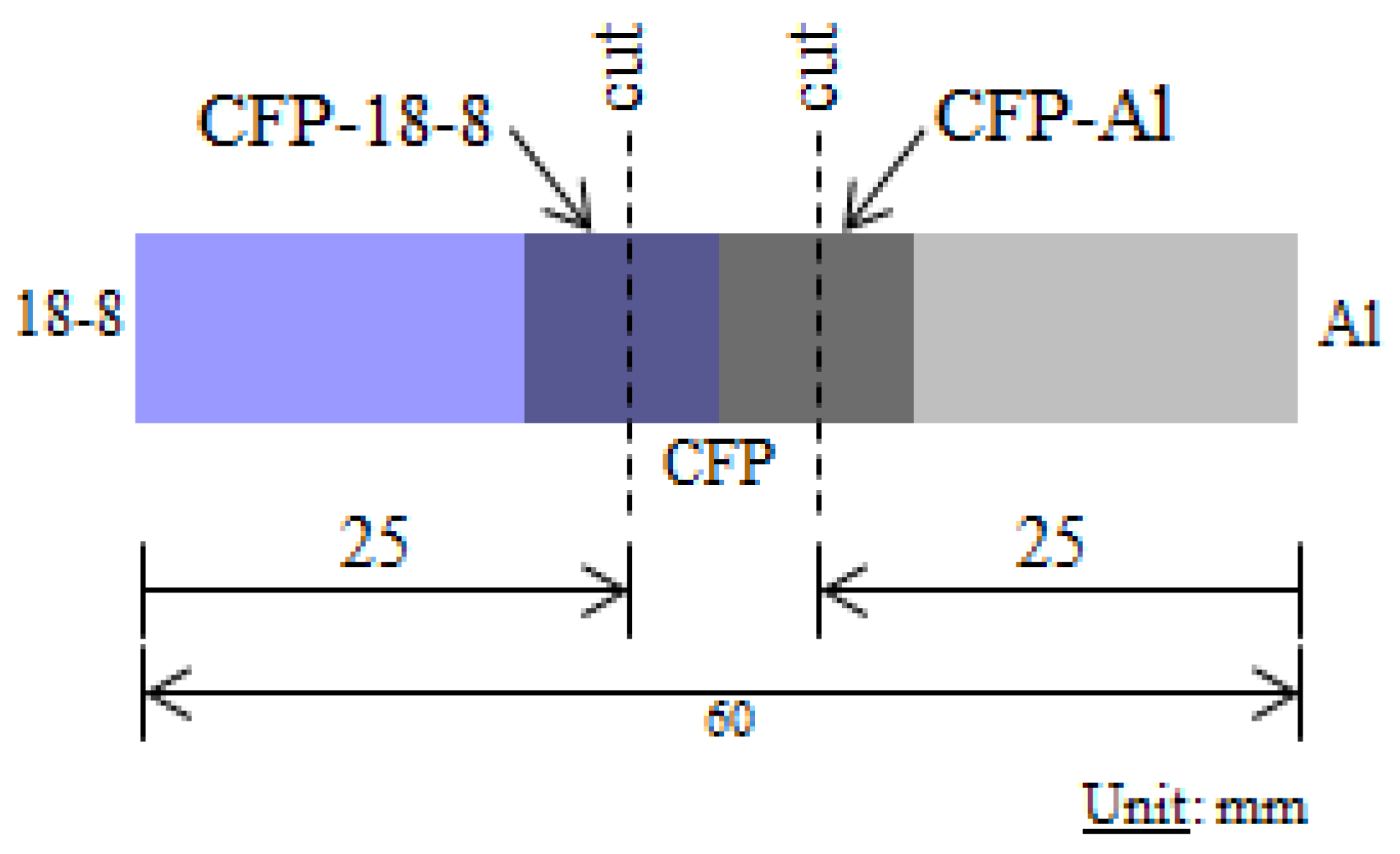
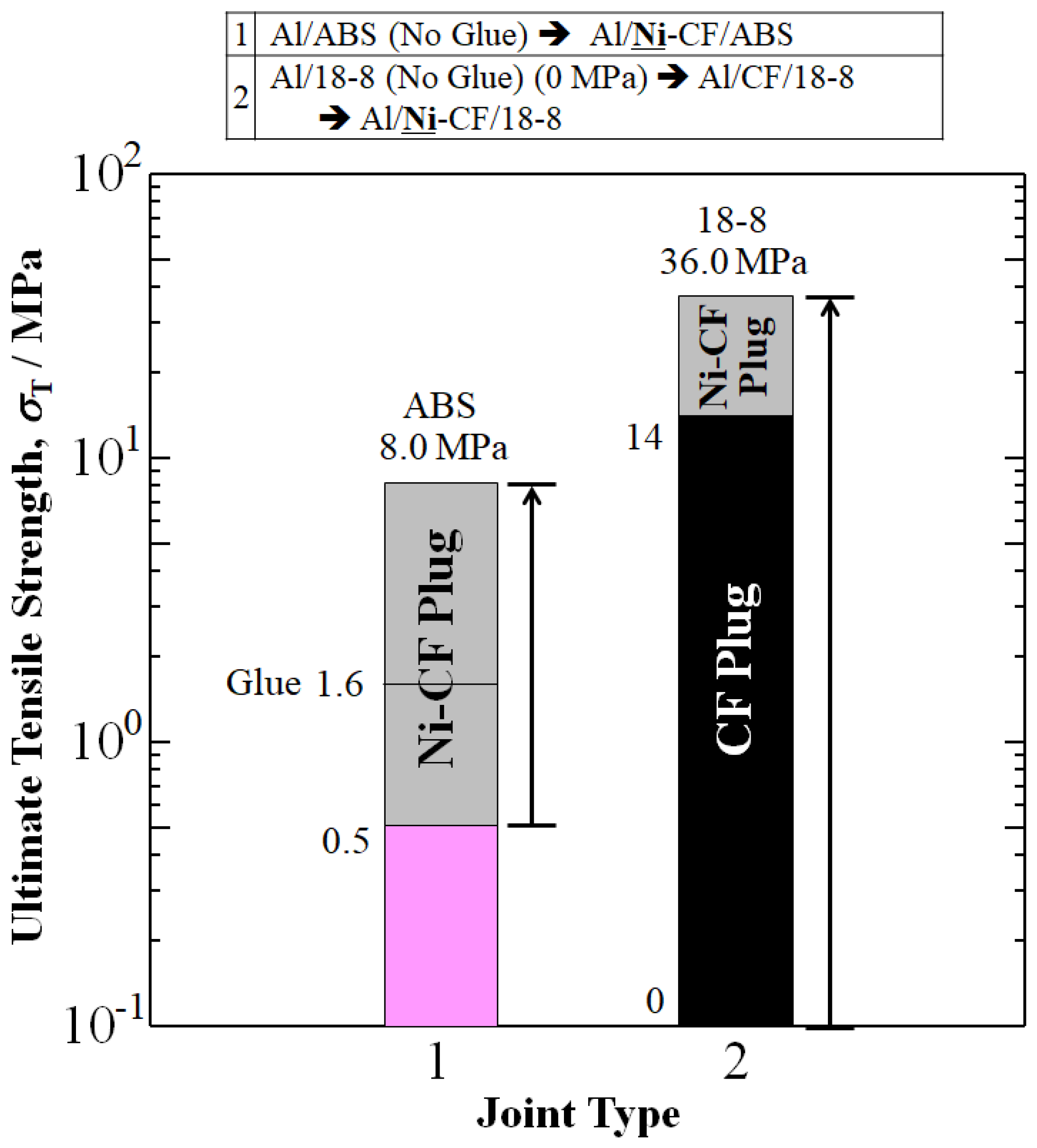
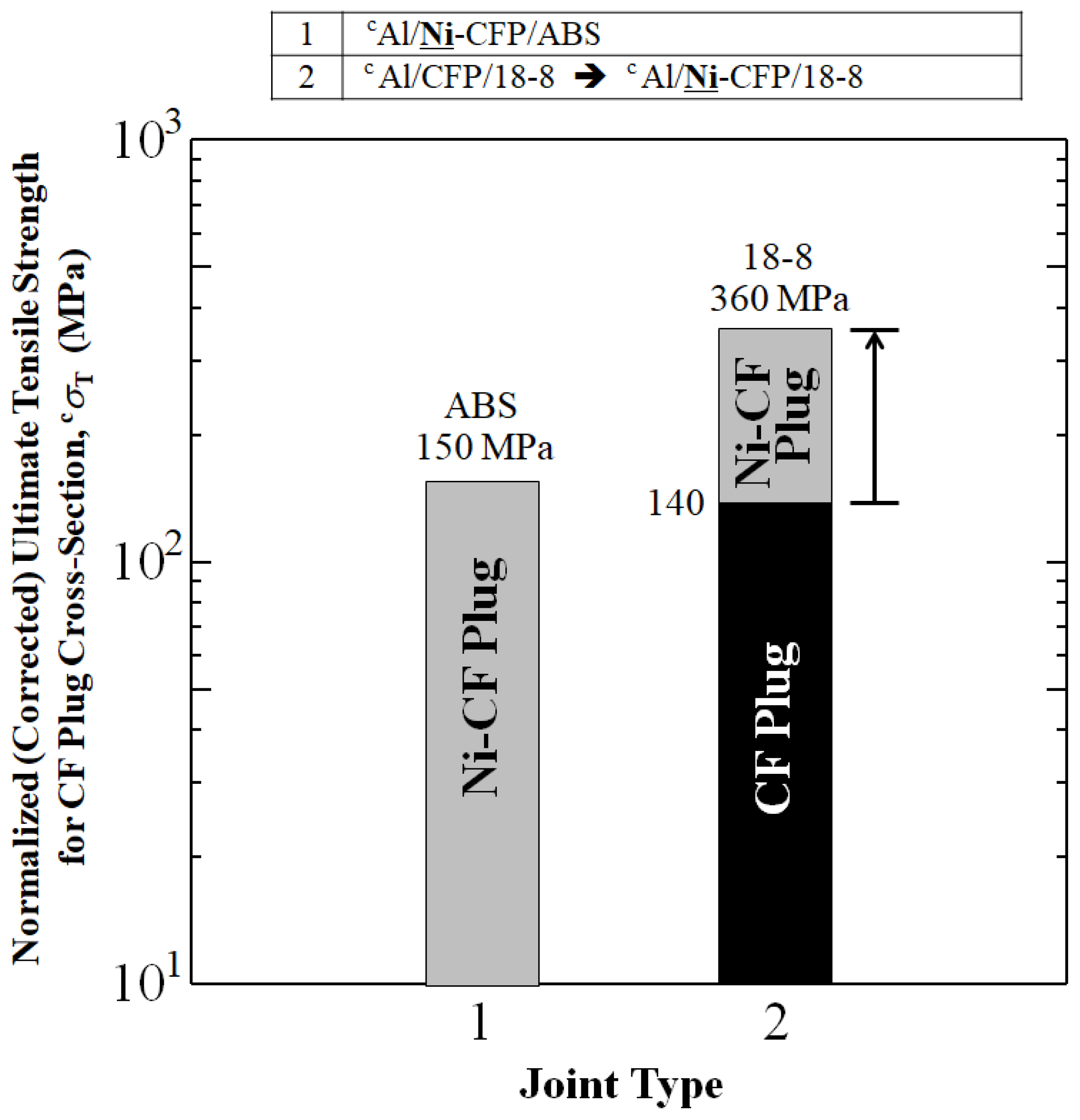

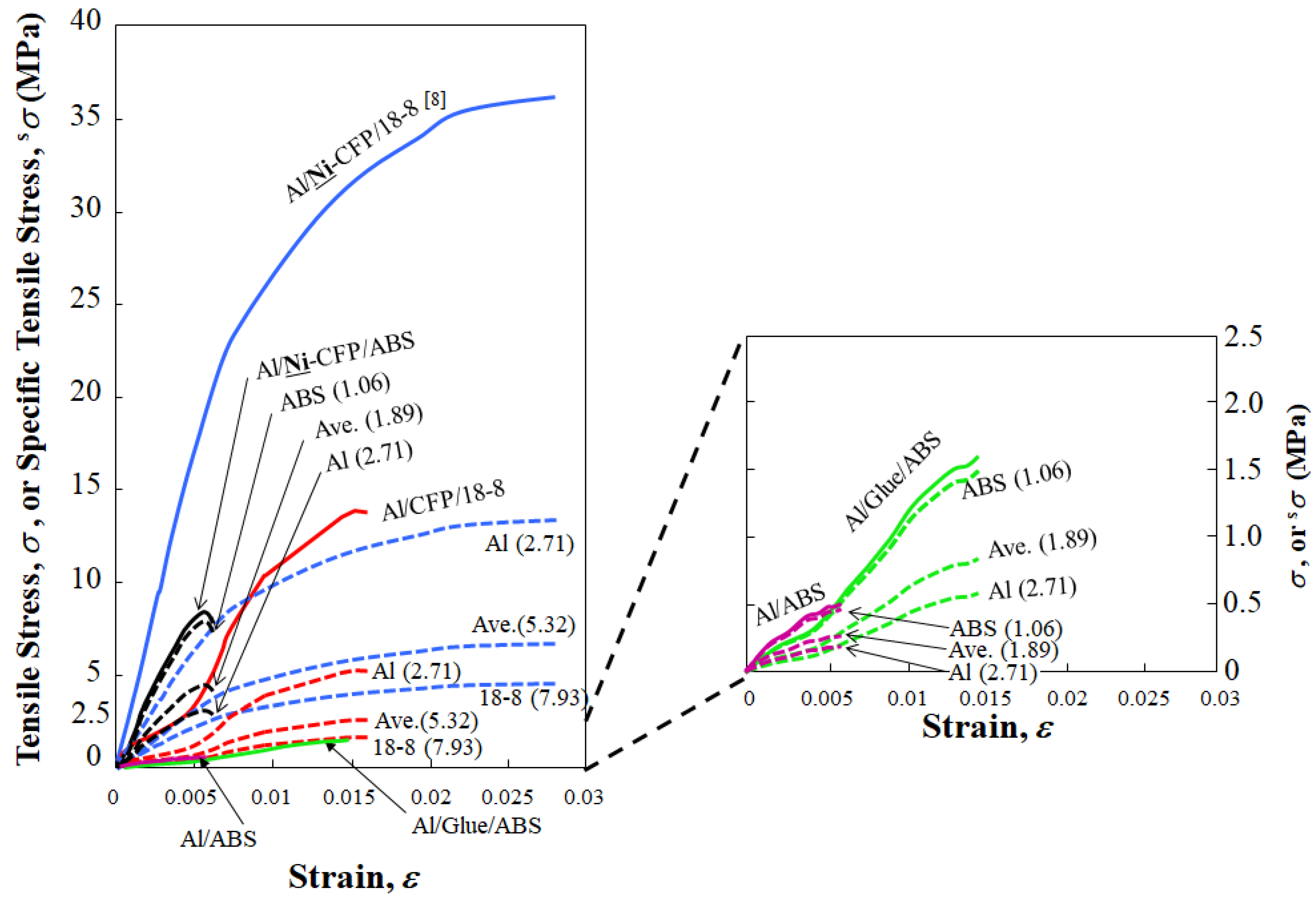
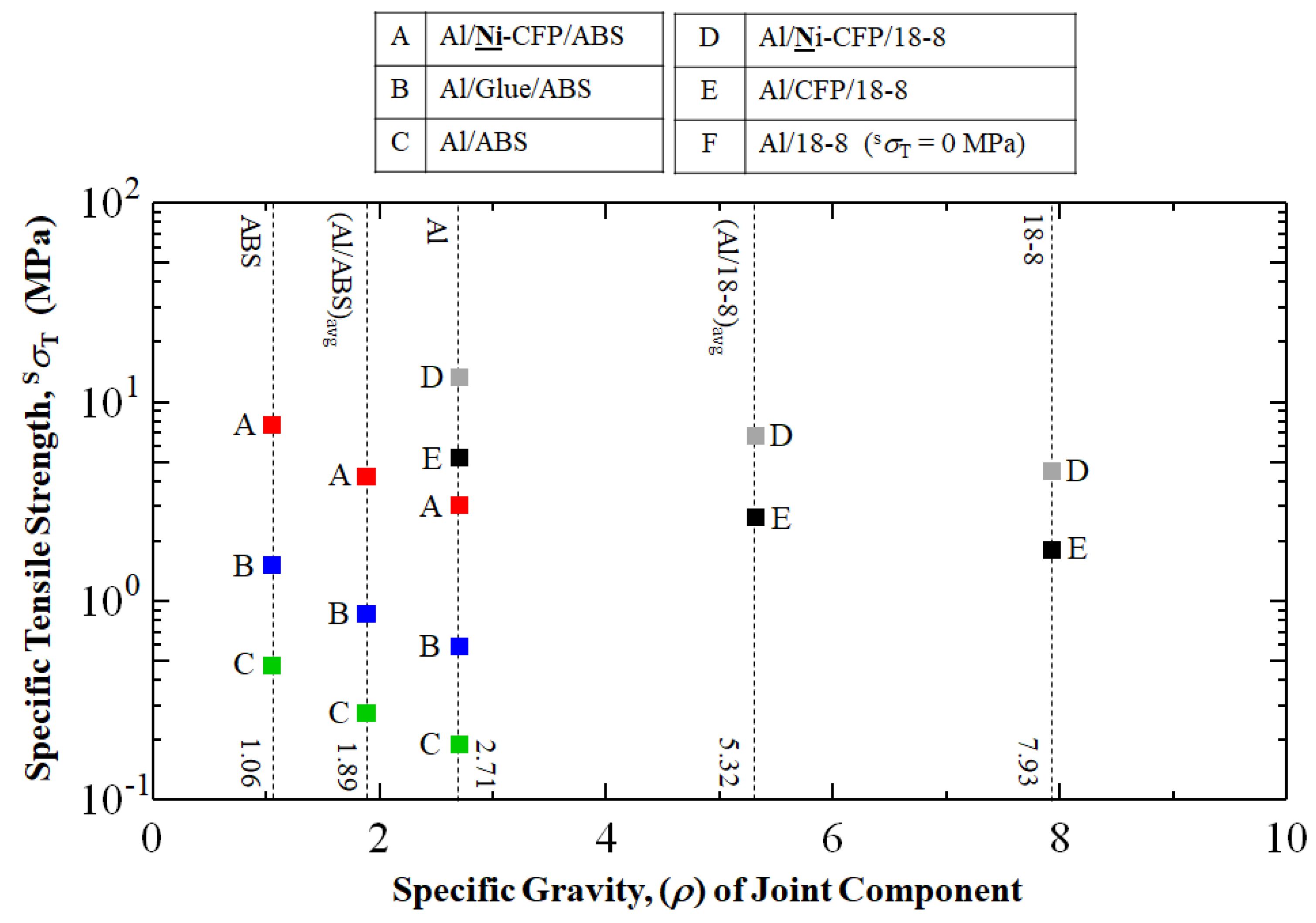
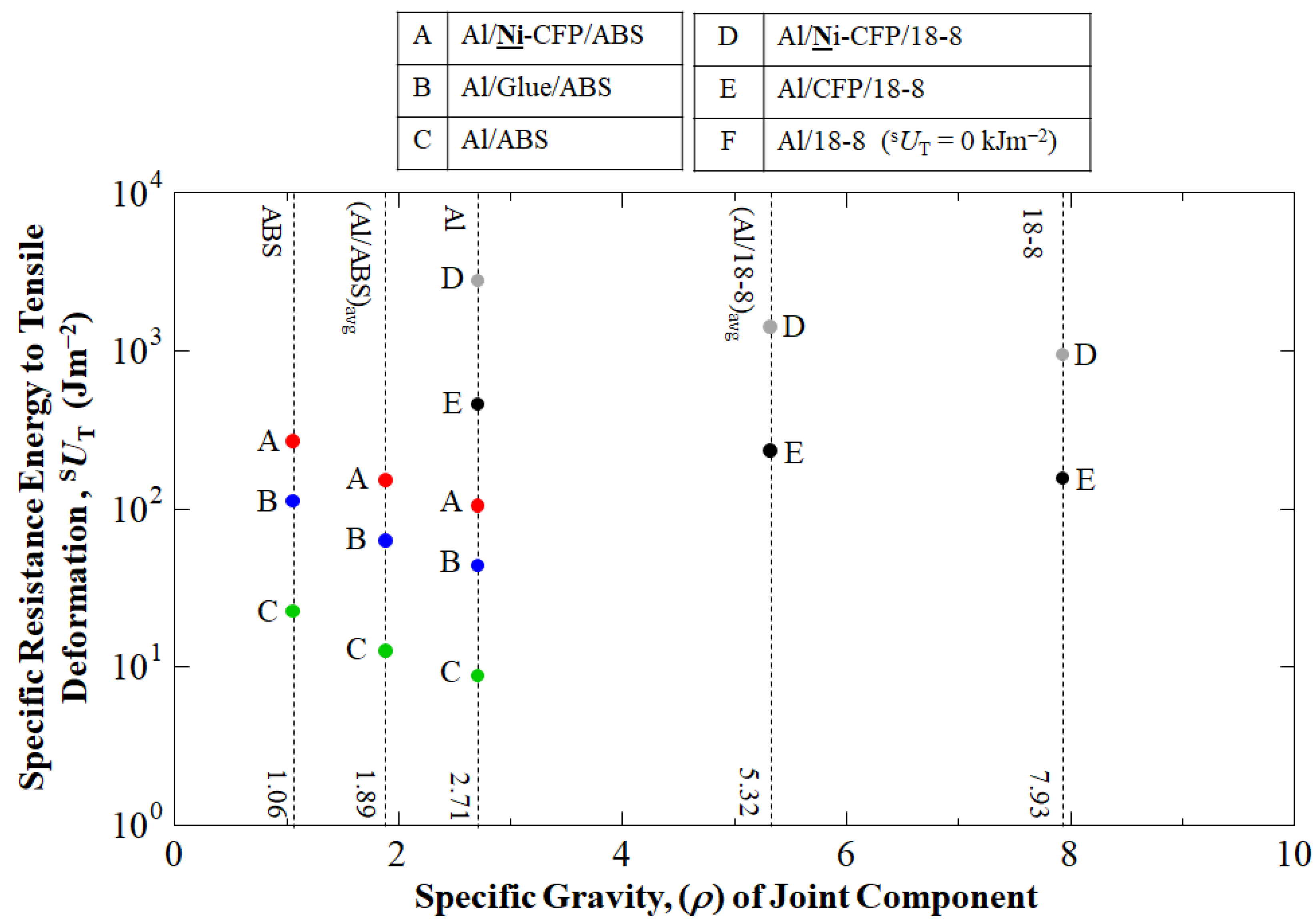
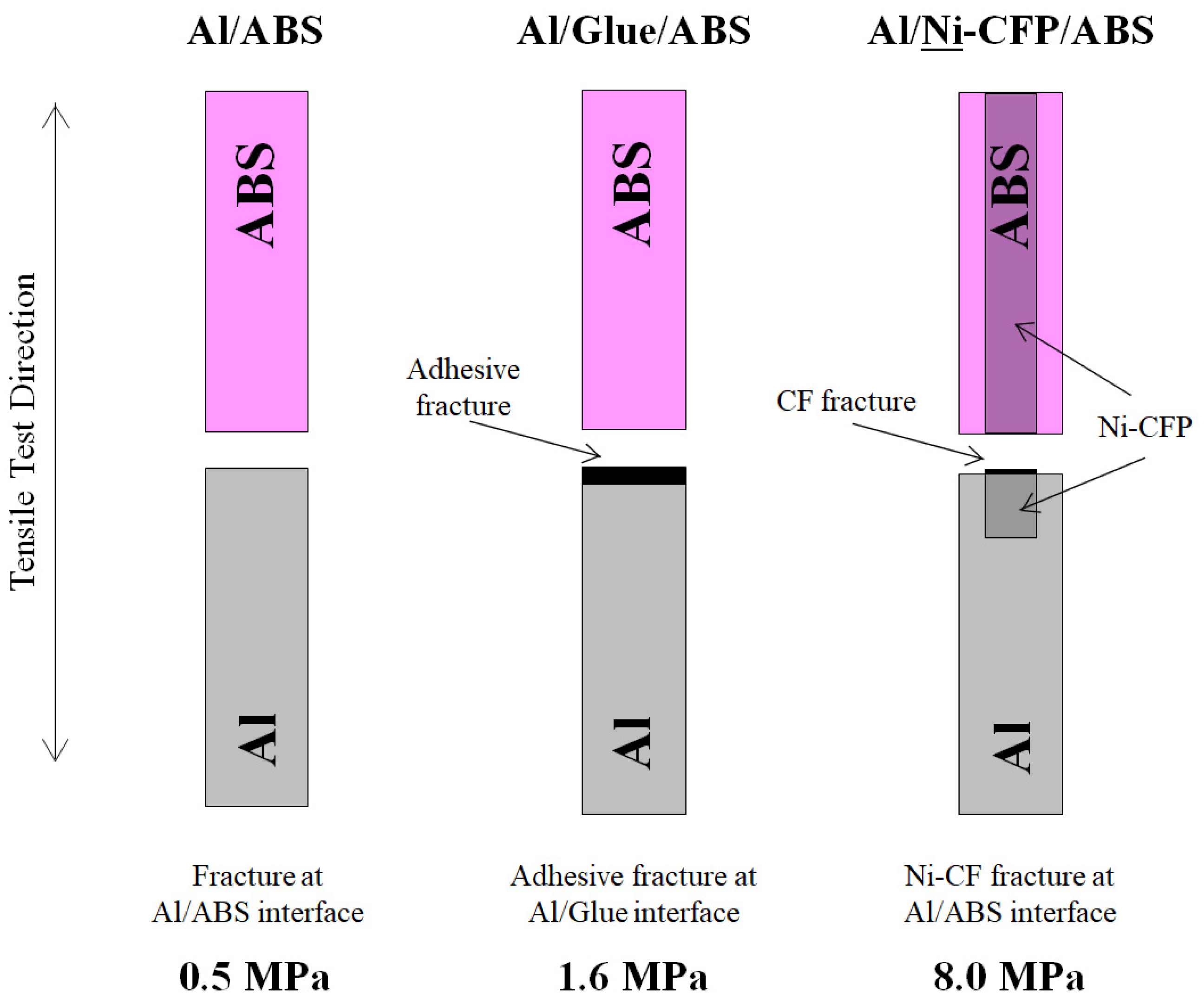

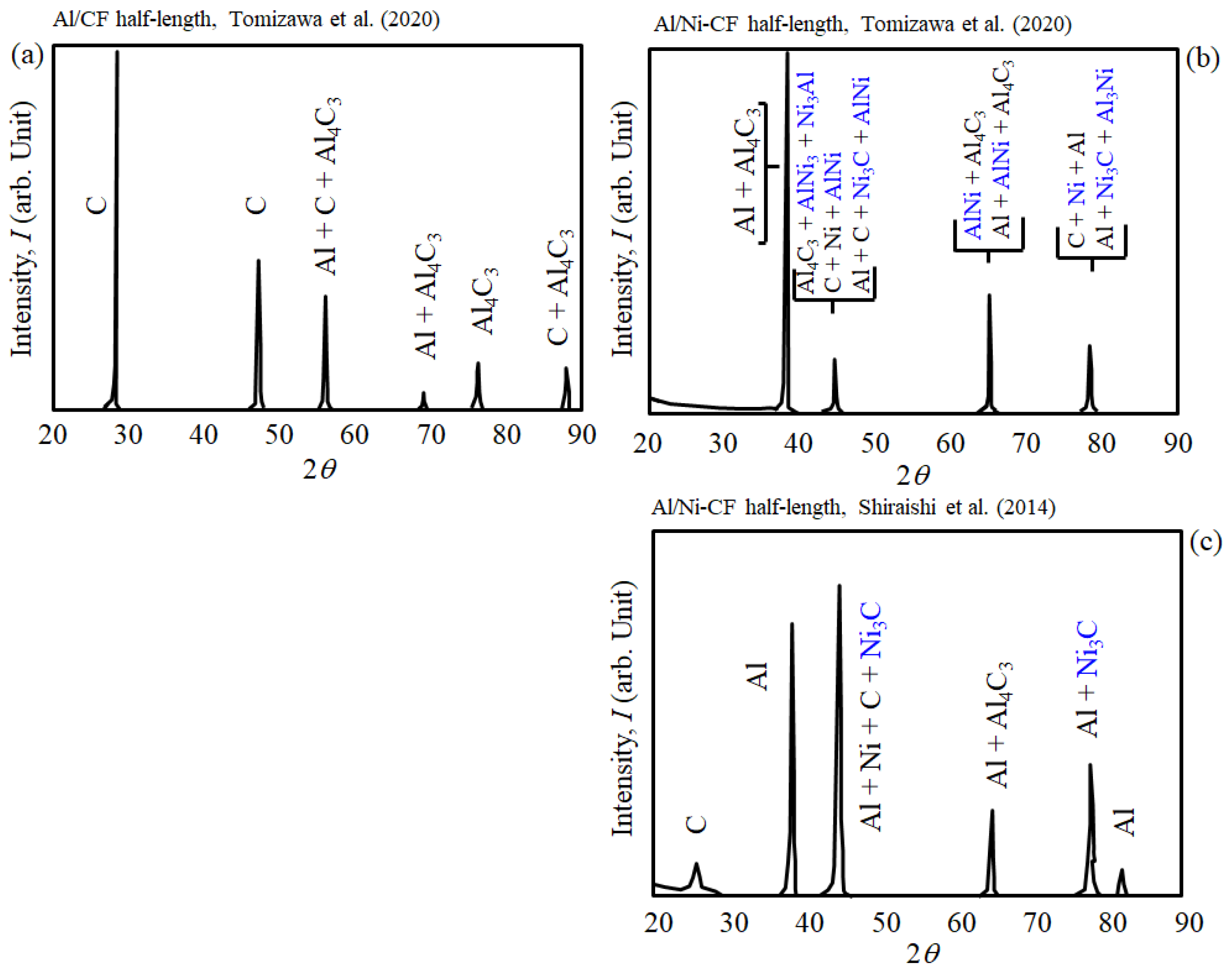

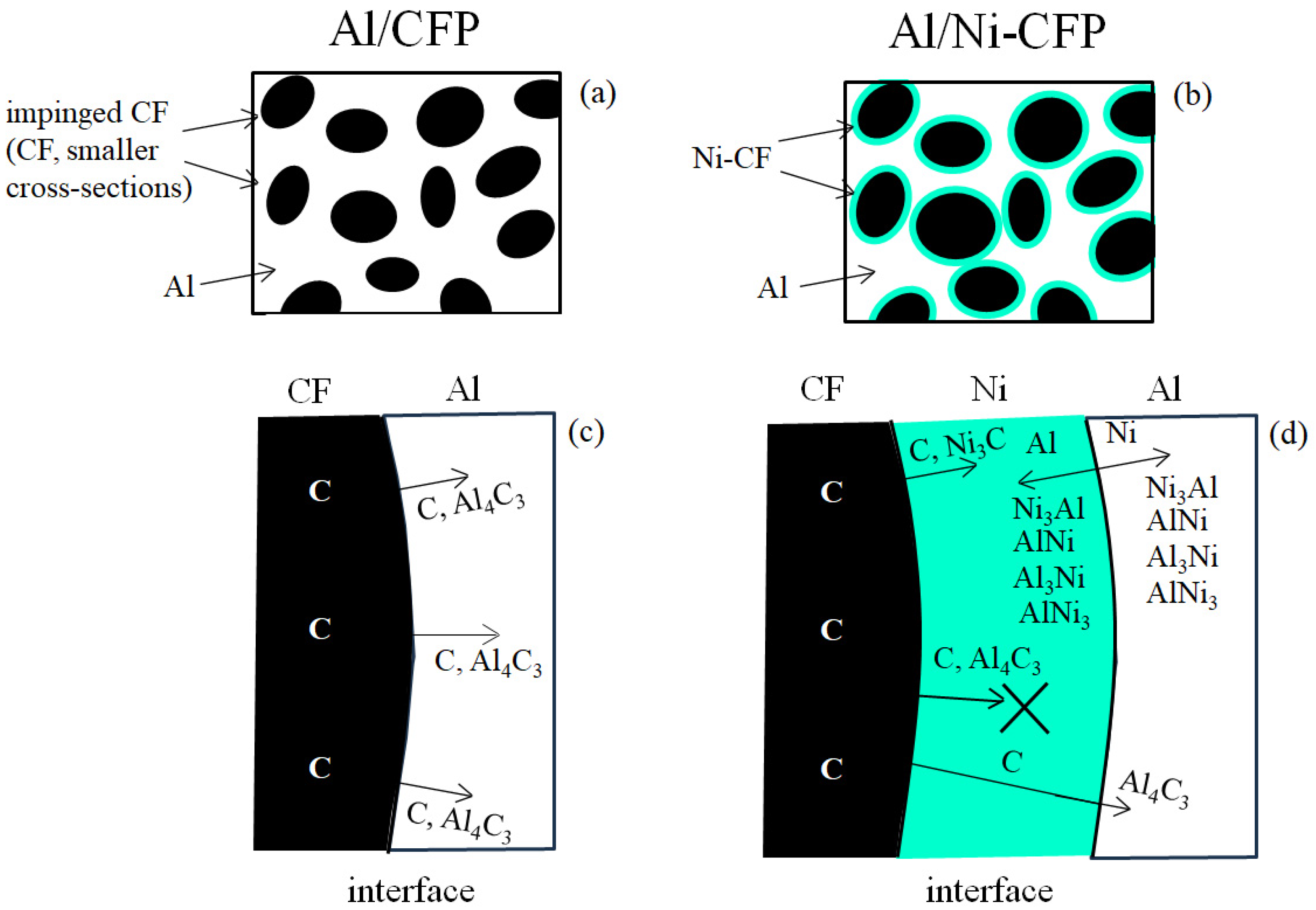
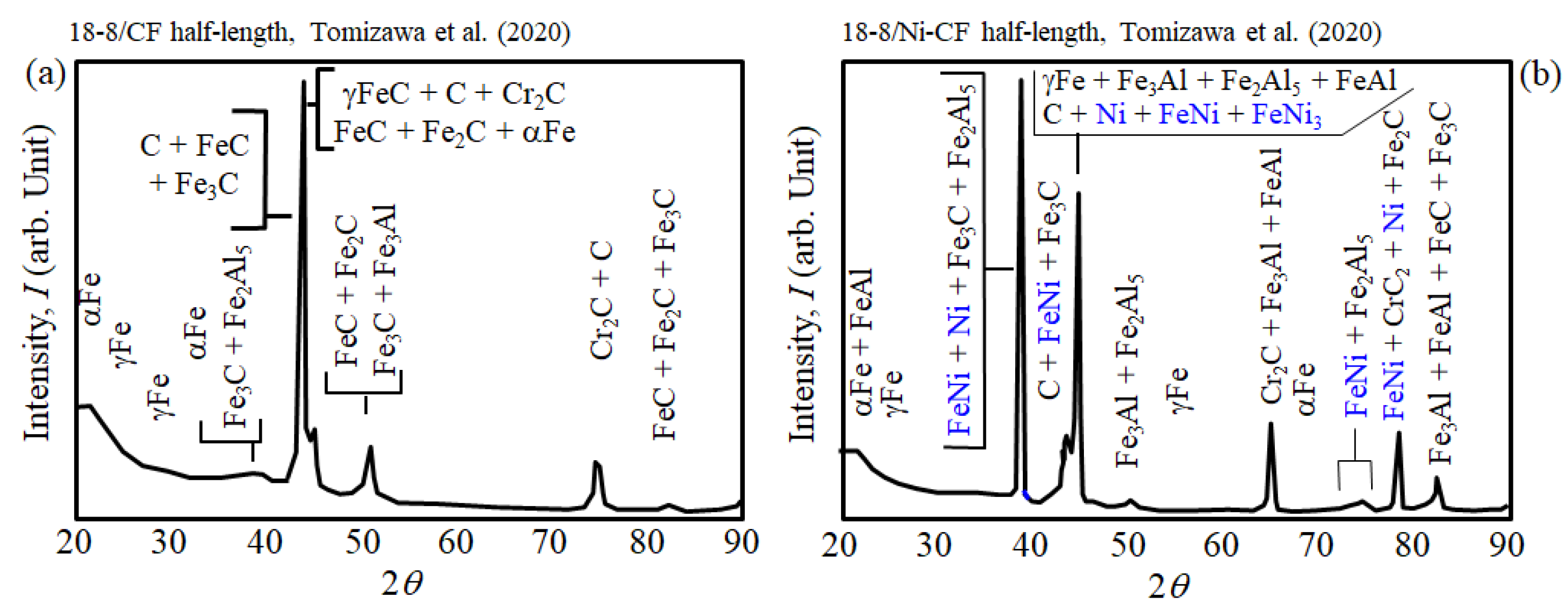
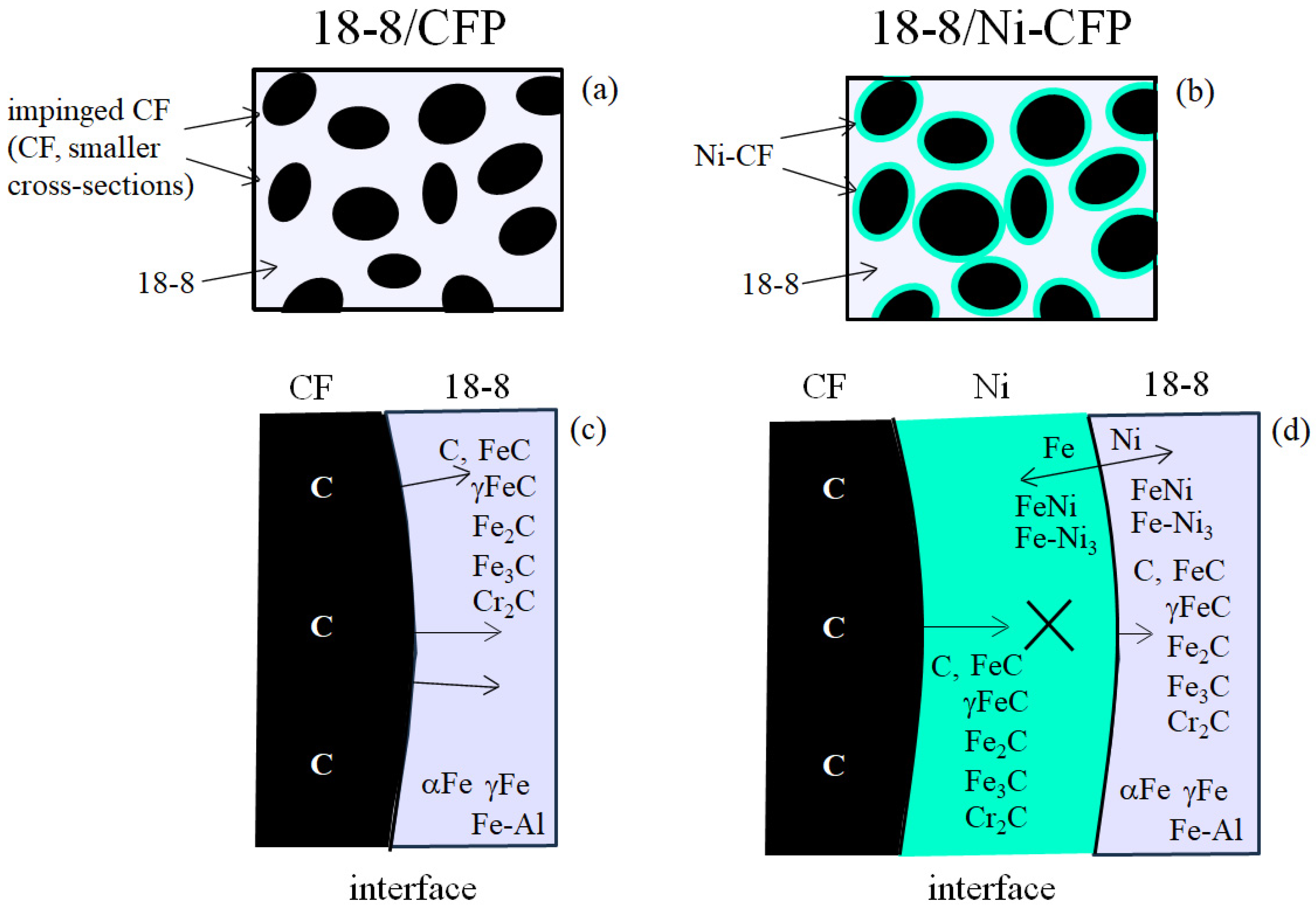

| Parameter | Value |
|---|---|
| Leak rate (Pa·m3·s−1) | 8 × 10−6 to 1 × 10−4 |
| Residual gas pressure (Pa) | below 1.5 × 10−3 |
| Ar gas sputtering pressure (Pa) | 5.0 ×10−1 |
| Sputtering potential (V) | 300 |
| Sputtering current (A) | 0.7 |
| Deposition rate (µm·h−1) | 30 |
| Parameter | Value |
|---|---|
| Current (A) | 1.5 |
| Voltage (V) | 7.0 |
| Electro-plating time (min) | 30 |
| Temperature (K) | 298 |
| Water solution: 400 mL with 12 g boric acid; 100 g nickel sulfate; 18 g nickel chloride | |
| JOINT (Units in mm) | l | w | t | CFP l | CFP w | CFP th | CFP in Al | CFP in ABS | CFP in 18-8 |
|---|---|---|---|---|---|---|---|---|---|
| Al/Ni-CFP/ABS-CFRTP | 70 | 10 | 3 | 42 | 5 | 0.3 | 7 | 35 | - |
| Al/Ni-CFP/18-8 | 60 | 10 | 3 | 20 | 10 | 0.3 | 10 | - | 10 |
| Al/ABS | 70 | 10 | 3 | - | - | - | |||
| Al/Glue/ABS | 70 | 10 | 3 | - | - | - |
| Joint | UT (kJm−2) | σT (MPa) | εT |
|---|---|---|---|
| [Al/Ni-CFP/ABS] | 0.285 | 8 | 0.006 |
| [Al/Glue/ABS] | 0.119 | 1.6 | 0.015 |
| [Al/ABS] | 0.0238 | 0.5 | 0.006 |
| [Al/Ni-CFP/18-8] | 7.54 | 36 | 0.028 |
| [Al/CFP/18-8] | 1.24 | 14 | 0.016 |
| [Al/18-8] | 0 | 0 | 0 |
Disclaimer/Publisher’s Note: The statements, opinions and data contained in all publications are solely those of the individual author(s) and contributor(s) and not of MDPI and/or the editor(s). MDPI and/or the editor(s) disclaim responsibility for any injury to people or property resulting from any ideas, methods, instructions or products referred to in the content. |
© 2023 by the authors. Licensee MDPI, Basel, Switzerland. This article is an open access article distributed under the terms and conditions of the Creative Commons Attribution (CC BY) license (https://creativecommons.org/licenses/by/4.0/).
Share and Cite
Nishi, Y.; Sagawa, K.; Faudree, M.C.; Uchida, H.T.; Kanda, M.; Kaneko, S.; Salvia, M.; Matsumura, Y.; Kimura, H. A Novel Nickel-Plated Carbon Fiber Insert in Aluminum Joints with Thermoplastic ABS Polymer or Stainless Steel. Materials 2023, 16, 5777. https://doi.org/10.3390/ma16175777
Nishi Y, Sagawa K, Faudree MC, Uchida HT, Kanda M, Kaneko S, Salvia M, Matsumura Y, Kimura H. A Novel Nickel-Plated Carbon Fiber Insert in Aluminum Joints with Thermoplastic ABS Polymer or Stainless Steel. Materials. 2023; 16(17):5777. https://doi.org/10.3390/ma16175777
Chicago/Turabian StyleNishi, Yoshitake, Kouhei Sagawa, Michael C. Faudree, Helmut Takahiro Uchida, Masae Kanda, Satoru Kaneko, Michelle Salvia, Yoshihito Matsumura, and Hideki Kimura. 2023. "A Novel Nickel-Plated Carbon Fiber Insert in Aluminum Joints with Thermoplastic ABS Polymer or Stainless Steel" Materials 16, no. 17: 5777. https://doi.org/10.3390/ma16175777







